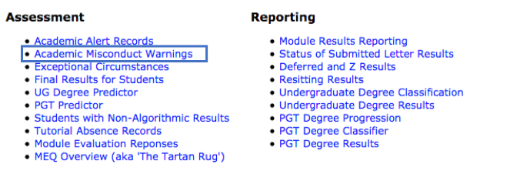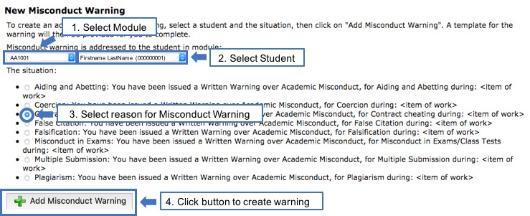Academic Misconduct Warnings
Introduction
Misconduct Warnings are the ‘written warning’ output from the misconduct process. They can be created by the Academic Misconduct Officer (AMO) or Head of School. The policy relating to misconduct warnings is the Policy on Good Academic Practice.
This section of the guide will cover:
Creating Misconduct Warnings
The written warnings are created by the AMO (or Head of School) via the ‘Academic Misconduct Warnings’ page, the link for which can be found in the ‘Assessment’ section of the school overview page. To access the school overview page – log into MMS and from the Modules page ensure the school is selected and then click the ‘View School’ button (see Figure 1)

Figure 1: To access the school overview select the school and then click the 'View School' button.
This will take you to the school overview page, the link to the Academic Misconduct Warnings is usually the second in the ‘Assessment’ section (see Figure 2).

Figure 2: Academic Misconduct Warnings link on School Overview page.
For faculty level staff the ‘Academic Misconduct Warnings’ link can be found in the ‘Other / Unclassified’ section of the faculty overview page.
To create a Misconduct Warning navigate to the misconduct warnings page and then:
- Select the module from the first drop down list, this will populate the second drop down list with students.
- Select the student from the second drop down list.
- Select the reason for the misconduct warning by selecting the check box to the left of the situation.
- Click the ‘Add Misconduct Warning’ button.
The steps are highlighted in Figure 3. This will create a new misconduct warning where you will be able to add more details to the situation and action fields. MMS will default sending the alert to the student, the AMO, Student Services, the Deans office, the Advisor of Studies/Supervisor, the Module coordinator (as defined in MMS) and Registry. More users can be cc’d by typing in the full email address (including @st-andrews.ac.uk) into the ‘New e-mail address’ field followed by the ‘Add E-mail Address’ button.
To save the alert, click the ‘Save Academic Alert’ button. Saving will not issue warning but will allow you to return at a later date. To complete and issue the misconduct warning click the ‘Issue Alert’ button.

Figure 3: First stage in creating a Misconduct Warning
Misconduct Warnings and the TGAP-REMEDIAL course
The TGAP-REMEDIAL course must be completed by any student who has received an issued misconduct warning. Once a student has completed the course in Moodle they will be able to download a certificate as proof they have completed it.
